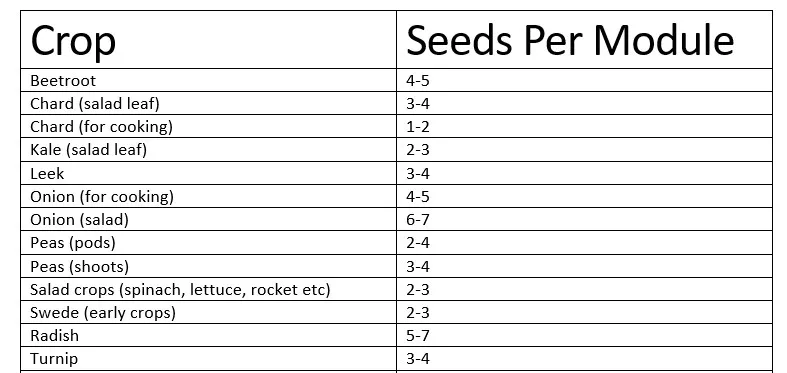🌱 It's Official. Planting Season Has Started!
🙌 Hip Hip Hooray! I recently came across a couple of Huw Richards's books and I'll share some tips with you. If you don't know Huw, he's a proper gardening guru.
🎥 Definitely check his YouTube Channel. A word of caution, you'll need to book annual leave to go through all of his videos. You won't be able to stop binging! 😂
💧 When sowing seeds, it's essential they don't dry out, but don't go to the other extreme and saturate them.

Sowing In Modules
🌱 For an efficient and productive vegetable garden, Huw recommends sowing seeds in modules under cover. You can get ahead when it's not warm enough to sow direct and have seedlings ready to plant when a previous crop is harvested.
☃️ Recently we've had a couple of snow surprises, this way your seedlings can survive and stay nice and cosy.
👇 What I really liked is this section; Multisowing.
Multisowing
👨🌾 Originally employed in large-scale vegetable production, this ingenious technique has only recently hit the home-growing mainstream thanks to organic grower and no-dig authority, Charles Dowding. Multiple seedlings are sown together and allowed to grow on, rather than being thinned when they reach a certain size.
🍎🍎🍎🍎 Beetroot, for example, can be sown in multiples of 4-5 seedlings. When transplanted, the beetroot will mature at different rates so you harvest only the biggest from each clump at a time. This form of succession growing and planting is not only ideal for small-space gardens but it also saves time on larger plots. Compared to traditional direct sowing, multisowing is a quicker, less wasteful, and more efficient method.
👇 See chart below which was adapted from information on Charles Dowding's website listing vegetables suitable for multisowing plus the target seed number per module.

Plant Companions
❤️ Charles Dowding once said that plants benefit from being multisown and then grown together because they like being "with their friends." This sums up perfectly the importance of communities, which is how plants grow and thrive in nature.
🌳 For example, different types of trees growing together in rural areas tend to live longer, healthier lives than single trees in urban settings.
👩🌾 It makes perfect sense to me. It seems to be less hassle. I'm happy to go this lazy gardening way!
🥕🥕🥕 Today, I actually pull out 3 carrots in my greenhouse, growing this way happily together. They were all nicely tangled, 2 of them were big mature size and the last one was in its middle stage. I decided to harvest them all. Mind you, I didn't know I was actually doing multisowing method. 😂
I believe I forget to thin them. I'll take it as sign I should go for it next time.
How to Sow in Modules
🌱 All you need is a potting bench, module tray, compost, water, and, of course, seeds!
- Fill a module tray with compost, preferably on a potting bench or other flat surface.
- Firm the compost with your hand so the surface is level.
- Water well and leave for 5 minutes to allow the compost to become thoroughly moist with no air pockets.
- Make a hole with your finger in each cell. Don't worry if the depth isn't accurate. To speed things up, Huw uses three fingers of one hand to make multiple seed holes at the same time. Bingo! I love this tip. If you do gardening with your kids, let them play their part too. You'll be done before you know it!
- Take your seeds and drop them into a hole. Don't worry if an extra seeds falls in. As mentioned above, you can go for multisowing method. Repeat until you've filled the tray.
- Add a large handful of compost to the middle of the tray and spread it out over the cells to cover the seeds, pressing down slightly.
- Label the tray and give it another water.
🥳 Give yourself a big pat on your back. Well done you! Your babies are in!
👇 Check this extra tip how to conserve moisture below.
Conserving Moisture
📦 Compost drying out is often the cause of poor germination rates. Seeds must be kept moist at this vital stage so need frequent watering. This can be time-consuming so to conserve moisture, Huw covers the whole seed tray with a layer of cardboard or a few layers of newspaper straight after watering. You don't need to water as often, even in very warm weather, because this method greatly reduces evaporation.
Here's what to do:
- Cut out a piece of cardboard slightly larger than the size of the module tray, or place 5-7 sheets of newspaper over the tray.
- Weigh down the four corners to anchor the cover, using pieces of wood or stones.
- After 3-4 days lift the cover to check moisture levels. If the top 1cm has dried out, water the compost surface and re-cover (unless there are signs of growth).
- As soon as you see any green shoots, remove the cardboard or newspaper and put it in the compost bin.
💪 I love this tip too! Less work for me!
🪓 For durable alternative to cardboard, measure and cut sections of wooden board to act as long term tray covers.
Watch Out For Damping Off!
⚠️ Good ventilation is vital for seedlings sown undercover to prevent damping off. This fungal disease, which causes seedlings to flop and eventually die, tends to take hold when combined with two other factors - overcrowding and overwatering. Sowing thinly, following good watering regime but not overdoing it and setting pots and trays on wire mesh with space between them will all help to keep this disease at bay.
🧤 Ready, Steady, Get your Green Fingers Ready!
What are you going to grow this year?

I hope it inspires you.🥰 Happy sowing and growing season!
From my heart ❤️ to your heart.❤️









